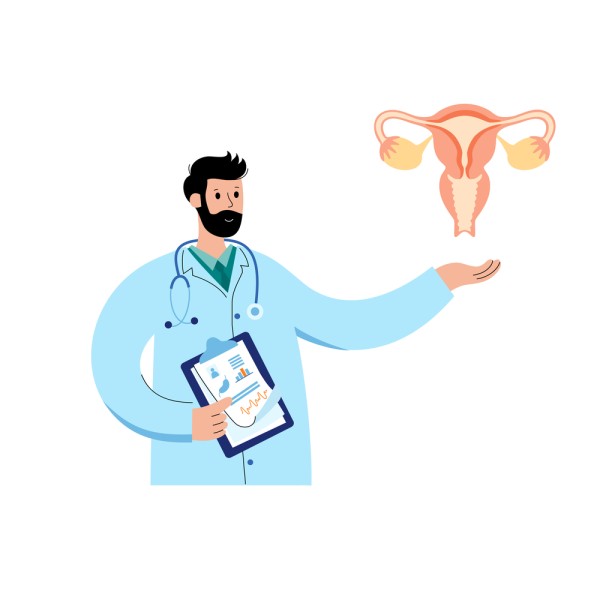If menstruation for you is:
√ the hardest week of the month,
√ longer than usual
√ comes with severe pain and terrible suffering
Like roughly 10% of all women, you might have endometriosis.
What is endometriosis? What causes it? How is it diagnosed? And most importantly – how is it treated? All of these questions are answered below.
What is endometriosis?
Endometriosis is a chronic inflammatory disease that affects women age (sometimes from the first menstrual period, but most often between 20-40). This disease is caused due to the presence of endometrium-like cells (cells similar to endometrial cells) outside the uterus in various areas, such as the ovaries, fallopian tubes, vagina, and even the intestines, rectum, and bladder.
The disease causes severe pain in the lower back and pelvis, especially around menstruation and ovulation, pain during intercourse, indigestion, and fertility problems.

What causes severe pain?
When menstruation occurs, uterine lining cells that thicken at the beginning of the menstrual cycle fall off in preparation for fertilization (which did not happen). The cells that resemble endometrial cells that have developed outside the uterus behave similarly and are affected by the hormonal change, just like the cells inside the uterus. These cells also fall out, just like in the menstrual process, but they have no opening through which they can drain out of the body, and they remain trapped in the abdominal cavity.
This can cause the development of various inflammatory processes inside the body. This is the reason for the intense pain, the feeling of bloating, fatigue, and depression, and even causing damage to a woman’s fertility.
It is theorized that endometriosis causes are due to hereditary predisposition, immune deficiencies, and various hormonal issues.
The symptoms and diagnosis
Diagnosing endometriosis is not simple and can take a long time for a doctor who is not familiar with it – the average diagnosis of endometriosis worldwide is 12 (!) years.
At the same time, a skilled and specialized doctor, who is well trained, can diagnose the disease relatively quickly by performing an ultrasound examination and a gynecological examination. For a definitive diagnosis of endometriosis, laparoscopic surgery (camera insertion through a tiny incision in the abdominal wall) and histological examination (microscopic examination of the suspected tissue structure) should be performed.
Possible symptoms of endometriosis:
- Sharp pain in the pelvis during menstruation, radiating to the lower body
- Gastrointestinal symptoms: diarrhea, soft stools, constipation, blood in stool, and pressure in the anus
- Symptoms reminiscent of UTI’s (urinary tract infection): Frequently urinating or pain when urinating
- Disposition to depression
- Chronic fatigue
- Pain during intercourse
If any of these symptoms occur, they should be reported to your family doctor or gynecologist. If the doctor suspects endometriosis, the doctor will refer the patient for further diagnostic exams to a specialist.
There are specific medical centers and doctors who specialize in endometriosis. They will continue to fulfill the diagnosis with more detailed and thorough questioning regarding the symptoms reported by the patient.
The initial physical examination to diagnose the disease includes an ultrasound of the pelvic area and sometimes an MRI. The results of this test will determine if further examination is necessary, and if so, a histological analysis as well as a laparoscopic exam will be performed.
How to treat endometriosis
The spread of the disease can impair fertility and cause the patient immense suffering, while harming her quality of life. Therefore, diagnosing the condition as soon as possible may assist in significant pain relief and prevent impairment of fertility.

Ways to treat endometriosis are
- Medication – Painkillers may alleviate chronic suffering, but do not solve the problem. With such severe pain, opioid medications can be prescribed, but these are addictive medications that have serious side effects. In addition, in exceptional cases, it will be possible to obtain a permit to use medical cannabis, from the Ministry of Health.
- Hormonal therapy – Hormonal therapies are the most common treatment for endometriosis, and their goal is to control the hormonal imbalance that causes the disease to thrive.
- Surgical treatment – performing a laparoscopy to treat lesions that have developed due to endometriosis: resection of cysts, release of adhesions, resection of tissue infected with endometriosis and more, all in accordance with the woman’s desire to conceive, and in accordance with her medical condition. A hysterectomy may also be an effective procedure in the case of endometriosis.
- Alternative medicine – a combination of conventional treatment along with dietary adjustment, adherence to quality sleep and alternative therapies (acupuncture, pelvic floor physiotherapy and more) – may relieve pain and improve the quality of life of those suffering from endometriosis.
Menstrual pain, and what about pregnancy?
Women who have endometriosis will usually feel aggravated in the first three months of pregnancy and then relief will come in the fourth month.
In addition, egg freezing and fertility retention are processes that are recommended for women who suffer from this disease and are not interested in getting pregnant soon.


